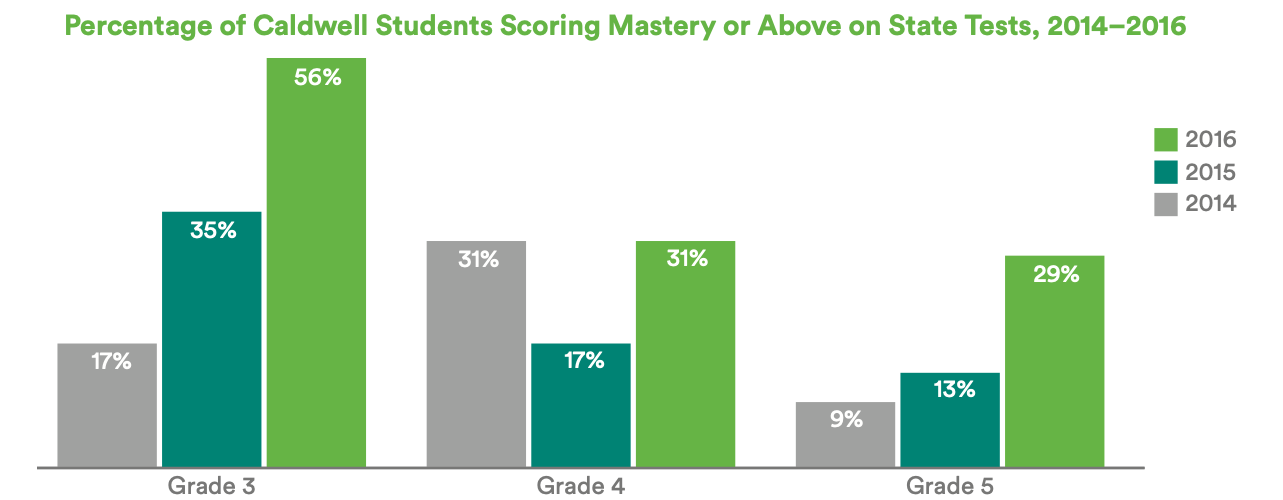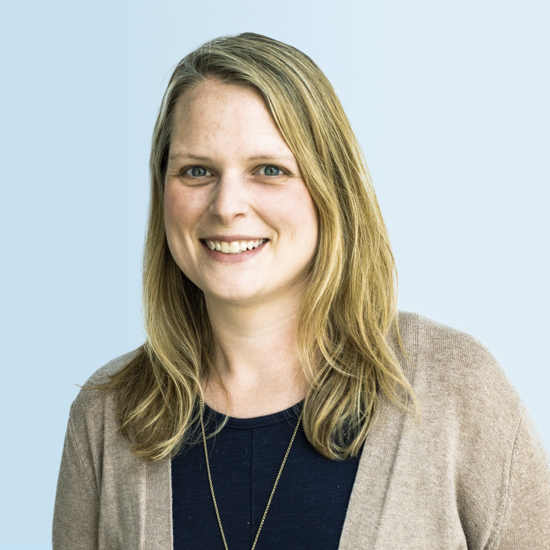Posted in: Aha! Blog > Eureka Math Blog > Professional Development Data Stories Student Achievement > Caldwell Parish (LA): Rural district is one of state’s fastest-improving
Caldwell Parish Schools (LA) started implementing Eureka Math® district-wide in 2014–2015, and it is among the state’s fastest-improving districts. Math used to be the district’s weakness, but it’s now becoming a strength, according to Robin Nelson (Director of K–5 Math). The district is in a rural area in the north-central part of the state. It has three elementary schools, one middle, and one high school. It enrolls 1,548 students, 73% of whom are considered low-income.

We recently spoke to Robin and her colleague, Nicki McCann (High School Director and Director of Accountability), along with Emily Bradley (who leads the state’s Network Team that supports dozens of districts).
WHAT’S DIFFERENT FOR STUDENTS SINCE YOU STARTED USING EUREKA MATH?
"The hard work pays off. I recently observed a 2nd grade classroom and witnessed a student explain why she chose one strategy over another to solve a problem. Seeing such conceptual understanding along with application was a memorable moment for me! Instead of producing robots, we're producing thinkers."
— Robin Nelson, Director of K–5 Mathematics
 Nicki: I can speak from my own experience as a parent. My own kids are 23, 16, 14 and 7 (twins). I’m just amazed what my 1st graders can do and their conceptual understanding. They understand the concept of 10s and 1s, and can add two-digit numbers in their heads, while my older kids could not do this at that age. It’s not the kids who are different, it’s the work they are doing in math class.
Nicki: I can speak from my own experience as a parent. My own kids are 23, 16, 14 and 7 (twins). I’m just amazed what my 1st graders can do and their conceptual understanding. They understand the concept of 10s and 1s, and can add two-digit numbers in their heads, while my older kids could not do this at that age. It’s not the kids who are different, it’s the work they are doing in math class.
 Robin: This class of 3rd graders is the first who have been taught Eureka Math from the beginning. That’s part of our success. Ninety-three percent of them are proficient in math. Math has always been our weakness compared with other subjects, but now it’s becoming our strongest subject area. We’ve never had such high math scores!
Robin: This class of 3rd graders is the first who have been taught Eureka Math from the beginning. That’s part of our success. Ninety-three percent of them are proficient in math. Math has always been our weakness compared with other subjects, but now it’s becoming our strongest subject area. We’ve never had such high math scores!
Teachers are so surprised at the knowledge and number sense their incoming students have. They’re moving instructionally at a faster pace.
WHAT DID IT TAKE TO GET THESE RESULTS?
Robin: It has been a process, as we didn’t have full buy-in from the beginning. We started the process with a few teachers who implemented the Eureka curriculum with enthusiasm and fidelity in each school. When other teachers saw those teachers’ student scores going up, the enthusiasm for the curriculum began to grow and then became contagious. We began to offer peer observations and collaboration in PLC’s (Personal Learning Communities) to support the use of Eureka Math.
Nicki: Once teachers realized they didn’t have to teach every strategy word for word, that helped. They could look vertically across the curriculum to see which strategies were absolutely necessary and which could be scaled back. Robin: It was also eye-opening for the teachers to realize that mastery of many standards came later than when they are first introduced. A standard may be introduced in 3rd grade but mastery is not expected until 6th grade. The spiral review helps when taking skills and applying to real-world problemsolving.
HOW HAVE YOU SUPPORTED PARENTS?
Robin: The first year was difficult for parents. Many of them didn’t understand some of the strategies that were being taught in class. The approach was different from how they’d been taught and parents grew frustrated when they weren’t able to help their children with homework at home. We tried to be proactive by holding parent informational meetings and school math nights. We also borrowed another district’s parent newsletter, which aided in the parents’ understanding.
HOW DID YOU SUPPORT TEACHERS?
"Once teachers realized they didn't have to teach every strategy word for word, that helped. They could look vertically across the curriculum to see which strategies were absolutely necessary and which could be scaled back."
— Nicki McCann, high school director and director of accountability
Robin: We recognized early on that many of our teachers needed help. With funding from a grant, we partnered with Louisiana TechUniversity to offer monthly professional development to all math teachers, kindergarten through Algebra 2. They were able to improve their own math skills and see the vertical alignment across the curriculum. We also received a great deal of help from our state education department Network team. We held job-embedded training to assist with the transition to the Louisiana state standards.
Emily: A common challenge among the districts with which we work is making sure teachers have a better grasp of the content. Once they understand the curriculum better, see the whole picture, and have some success, it’s a lot easier.
WHAT ARE SOME CURRENT CHALLENGES YOU’RE GRAPPLING WITH?
Nicki: High school is a big challenge. Many of the students are coming in with big gaps in knowledge that teachers need to fill. A lot of my teachers aren’t certified in math, so we’re relying on our state Network Team to provide professional development for my staff and myself. Teacher turnover is always a challenge in a small district like ours. It’s daunting to find teacher applicants who are certified in math.
WHAT ADVICE DO YOU HAVE FOR OTHER DISTRICTS?
"Be patient, better days are coming and it's worth it."
— Nicki McCann, High School Director and Director of Accountability
Emily: Know that you don’t have to teach every strategy. Instead, you need to teach the concepts. There are multiple ways to get an answer, so let your students explore the different routes.
Nicki: Be patient, better days are coming and it’s worth it. I was the valedictorian at Caldwell High, but had to take the ACT four times to get out of remedial math in college. I could plug numbers into a formula, but I didn’t have the conceptual understanding to solve a problem if I didn’t have the formula. We want to give our kids enough understanding of math that they don’t have to take remediation in college.
Robin: The hard work pays off. I recently observed a 2nd grade classroom and witnessed a student explain why she chose one strategy over another to solve a problem. Seeing such conceptual understanding along with application was a memorable moment for me! Instead of producing robots, we’re producing thinkers.
Submit the Form to Print

Jenny Taylor
Jenny has over a decade of experience in education policy and research. She has worked with states and districts on the development and implementation of college and career readiness policies, especially around the implementation of rigorous standards and high-quality instructional materials. She has extensive knowledge about K–12 standards, graduation requirements, assessments, and accountability systems nationwide. Additionally, she has conducted research for school districts to address pressing needs in those districts. Jenny received her B.A. in English and education from Bucknell University and her M.Ed. in education policy from the University of Pennsylvania Graduate School of Education.
Topics: Professional Development Data Stories Student Achievement












